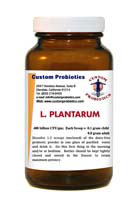Lactobacillus plantarum: Difference between revisions
| Line 16: | Line 16: | ||
Family : Lactobacillaceae | Family : Lactobacillaceae | ||
Genus : | Genus : Lactobacillus | ||
Species : | Species : plantarum | ||
Revision as of 14:39, 24 April 2010
Classification
Domain : Bacteria
Phylum : Firmicutes
Class : Bacilli
Order : Lactobacillales
Family : Lactobacillaceae
Genus : Lactobacillus
Species : plantarum
Species
|
NCBI: Taxonomy |
Lactobacillus plantarum
Description and Significance
L. plantarum is a gram positive bacteria. It is aerotolerant and grows optimally at 15 degrees Celcius.
Genome Structure
Describe the size and content of the genome. How many chromosomes? Circular or linear? Other interesting features? What is known about its sequence?
3,308,274 bp
circular chromosome
Cell Structure, Metabolism and Life Cycle
Interesting features of cell structure; how it gains energy; what important molecules it produces.
Ecology and Pathogenesis
Habitat; symbiosis; biogeochemical significance; contributions to environment.
If relevant, how does this organism cause disease? Human, animal, plant hosts? Virulence factors, as well as patient symptoms.
Often isolated from plant material and the gastrointestinal tract of animals.
Used as a probiotic
References
http://www.pnas.org/content/100/4/1990.long
http://www.ncbi.nlm.nih.gov/sites/entrez?Db=genomeprj&Cmd=Retrieve&list_uids=32969
http://aem.asm.org/cgi/content/short/71/3/1223
Author
Page authored by Stephanie LaHaye and Jason McIntyre, student of Prof. Jay Lennon at Michigan State University.



